[ENG]Jesús Soto Modern Art Museum [ESP]Museo de arte moderno Jesús Soto
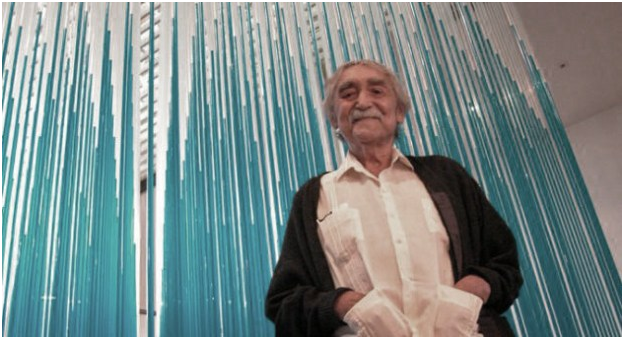
Jesús Soto, a Venezuelan artist, was born in Ciudad Bolívar in 1923 and died in Paris in 2005, where he lived since 1950. Already in life he was considered one of the main cultivators of kinetic and optical art. In France he suffered the influence of Paul Klee and Piet Mondrian, the latter motivated him to energize Neoplasticism. After a few years in Paris, in 1954, it occurred to him to capture in his series "Metamorphosis" a kind of musical seriality. In 1956 he presented his first kinetic structures ("Dynamics of color" and "Scriptures" belong to this period). In the 60s and 70s he designed penetrable and architectural integration works, such as the decoration of the "George Pompidou National Center of Art and Culture" in Paris, the interior of the UNESCO building and numerous public spaces in Caracas. In 1988 he made the Virtual Sphere for the Seoul Olympic Sculpture Park. In the 1990s he exhibited his work at the Museum of Modern Art in Kamakura, Japan (1990), at the Kunshalle in Cologne, Germany (1993) and at the MOMA in New York (1993).

The Museum of Modern Art that bears his name, and the subject of our post today, is located in Ciudad Bolívar, in southern Venezuela, a region lacking cultural infrastructure seven hundred kilometers from Caracas, was built by the initiative undertaken by the artist himself, who donated to this organization a varied collection of abstract, kinetic and constructivist art, thus initiating the creation of an institution dedicated to the research and dissemination of these artistic expressions. Soto envisioned an active museum, outside the traditional vision of passive observers, he saw it as a research center and historical collection of the most outstanding of universal modern art, where the visitor could enjoy the work of art for its aesthetic enjoyment, and at the same time learn with the unique sensory experience of contact with it.
This museum work was inaugurated in August 1973 and since its inception it became, in addition to a place for recreation, a center for research and informal education, through workshops that have made it worthy of being a benchmark of the country's museums.
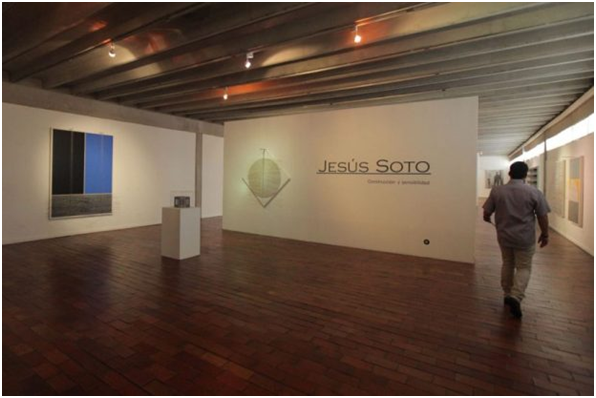
The Jesús Soto Museum of Modern Art building is the product of the productive mind of the Venezuelan architect Carlos Raúl Villanueva who designed a functionalist structure, in tune with the artistic principles of the works that are part of the museum's collection. Villanueva, in this, one of his latest works, applies his philosophy of integrating architectural design with painting, sculpture, landscape and man, the so-called “synthesis of the arts”. Its construction took a little over three years. The museum consists of seven rooms for exhibition, mainly paintings, of which three serve as a place for the exhibition of Soto's works, in addition there are two beautiful gardens that are enriched with magnificent sculptures. In the building a harmonious relationship is achieved between the covered spaces and the gardens, which is consolidated with the incorporation of the penetrable Azul y Blanco de Soto, there, the visitor can have the unique experience of feeling the dynamics, movement and the sensory character of the works of Jesús Soto.
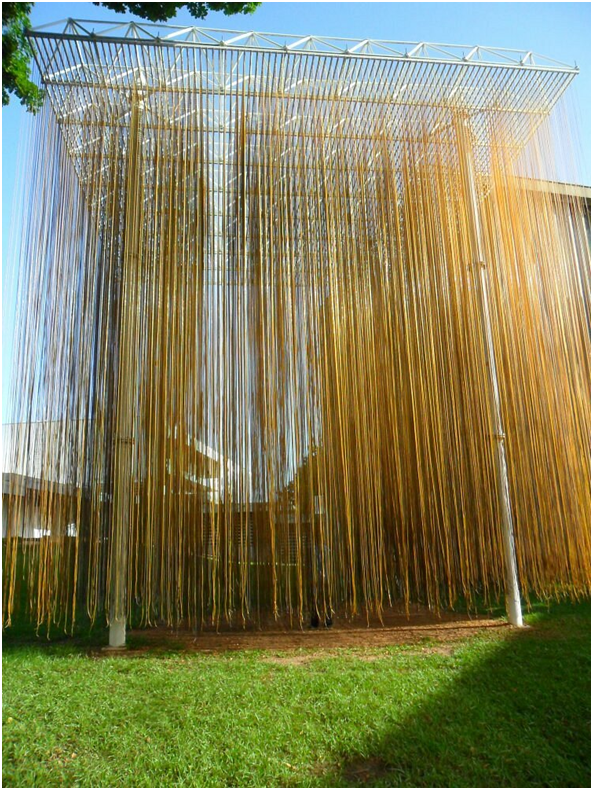
The museum was built in two stages, the first of which, inaugurated in 1973, consists of five quadrangular buildings of various sizes joined by a system of bridges that in turn join and separate the exhibition rooms, assembling a system of corridors; which are organized around a patio-garden of sculptures works that, combined with the landscaping and the architectural proposal, further enrich the experience that is lived throughout the visit to the museum, Villanueva succeeded in perpetuating an atmosphere of synthesis of the arts which are an aesthetic delight that one never tires of admiring. This stage covers an area of 1721 square meters, where the administrative offices and the first exhibition rooms are located. Its construction took a little over three years.
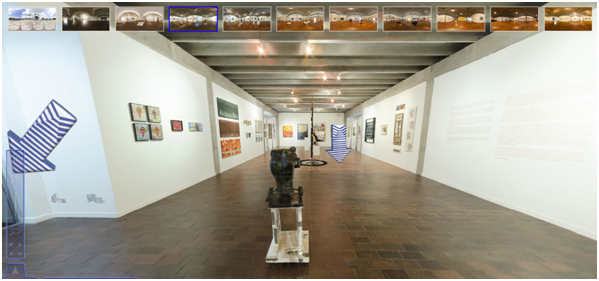
The second stage was inaugurated in 1987 and preserves the architectural guidelines left by the author, jealously respected by the architects José Carlos Villanueva and Edgar Parra. The second phase, with an area of 3489 square meters, consists of a multipurpose room, the library, a restoration workshop, warehouses and new exhibition rooms that add up to a total of 7 rooms, to which it would be necessary to add 7000 square meters of green areas and parking.
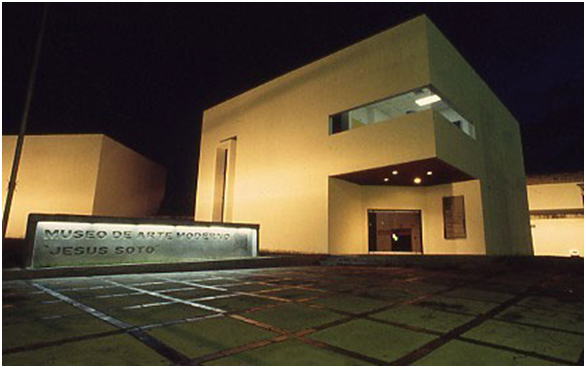
The material used in the manufacture of both stages is concrete because it is considered solid and austere, which is clearly manifested in buildings devoid of ornaments, where the clean work can be seen in the joints between beams, giving it a particular minimalist expressiveness always from a kinetic model full of light, shadows that are the hallmark of the cubist vision of space.

Image
The collection of the “Jesús Soto Modern Art Museum” is made up of around 730 works of the artist and some 130 national and international artists of the 20th century, which show, in addition to the Russian avant-garde, neoplasticism and geometric abstraction, the typical tendencies of the 20th century such as neoplasticism, kineticism, structuralism and the optical, geometric, concrete and monochromatic arts. The viewer can enjoy these artistic movements in a series of paintings, sculptures, multiples, serigraphs, photographs displayed throughout the exhibition rooms, which in themselves are pieces of architectural art. Among the artists with works in the museum are Kasimir Malevich, Robert Jacobsen, Alberto Magbelli, Kenneth Snelson, Georges Rickey, Natalia Gontcharova, Pavel Mansouroff, André Heurtaux, Man Ray, Josef Albers, Jean Tinguely, Fortunato Depero, Jean Gorin, Lucio Fontana, Lajos Kassak, Víctor Vasarely, Michel Seuphor, Henryk Stazewski, Mauro Reggiani, Auguste Herbin, Sonia Delaunay, Marcel Louis Baugnet, Serge Poliakoff, Wassil Kandinsky, Johannes Itten, Jean Arp, Theo Van Doesburg, Hans Richter, Ilya Chashnik, Liubov Popova and Henryk Berlewi and, of course, Jesús Soto.
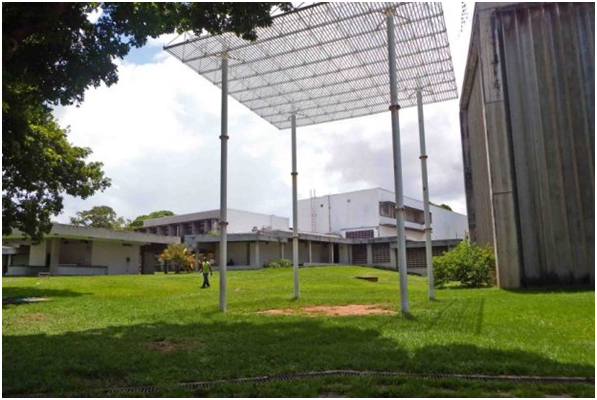
In 2011, the government of the State intervened the museum and ordered to take possession of all the museum's assets and real estate. Soto's son, Cristobal, who was in Paris, protested the raid and subsequent expropriation of the museum, because, in the words of Cristobal Soto himself, what happened was “a seizure of the property and the works of art of his father and of all the Venezuelan and foreign artists who generously decided to donate works to enhance the museum and enrich the spiritual heritage of the Bolívar state and the Republic”. To summarize and not tire Hive readers with the country's political diatribes, I will only say that the museum is currently in total disrepair, as was confirmed by Alejandro Lanz, director of the Venezuelan ecological research center.
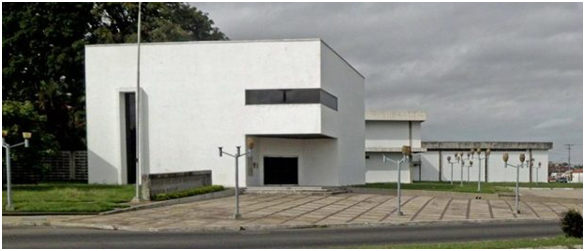
Jesús Soto, artista venezolano, nació en Ciudad Bolívar en 1923 y falleció en Paris en 2005, donde vivió desde 1950. Ya en vida fue considerado uno de los principales cultores del arte cinético y óptico. En Francia sufrió la influencia de Paul Klee y de Piet Mondrian, este último le motivó para dinamizar el neoplasticismo. A los pocos años en Paris, en 1954, se le ocurrió plasmar en su serie “Metamorfosis” una especie de serialidad musical. En el 56 presentó sus primeras estructuras cinéticas (”Dinámica del color” y “Escrituras” pertenecen a este periodo). En las décadas de los 60 y 70 diseñó penetrables y obras de integración arquitectónica, como la decoración del “Centro Nacional de Arte y Cultura George Pompidou” en París, el interior del edificio de la UNESCO y numerosos espacios públicos en Caracas. En 1988 realizó la Esfera Virtual para el Parque Olímpico de Escultura de Seúl. En los años noventa expuso su trabajo en el Museo de Arte Moderno de Kamakura, Japón (1990), en la Kunshalle de Colonia, Alemania (1993) y en el MOMA de Nueva York (1993).
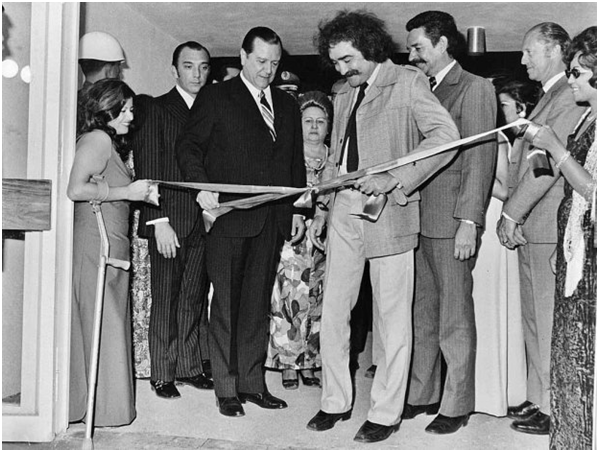
El Museo de Arte Moderno que lleva su nombre, y tema de nuestro post de hoy, se encuentra ubicado en Ciudad Bolívar, al sur de Venezuela, una región carente de infraestructura cultural a setecientos kilómetros de Caracas, fue construido por la iniciativa emprendida por el propio artista, quien donó a esta institución una variada colección de arte abstracto, cinético y constructivista, iniciando así la creación de una institución dedicada a la investigación y divulgación de estas expresiones artísticas. Soto vislumbraba un museo activo, fuera de la visión tradicional de observadores pasivos, lo veía como un centro de investigación y de acopio histórico de lo más destacado del arte moderno universal, donde el visitante podía disfrutar de la obra de arte para su goce estético, y a la vez aprender con la experiencia sensorial única del contacto con ella.
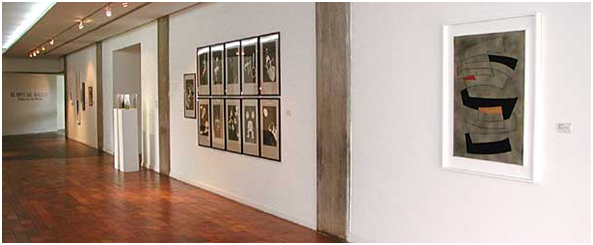
Esta obra museística fue inaugurada en agosto de 1973 y desde sus inicios se convirtió, además de un lugar para la recreación, en un centro para la investigación y la educación informal, por medio del dictado de talleres que le han hecho merecedor de ser un referente de los museos del país.
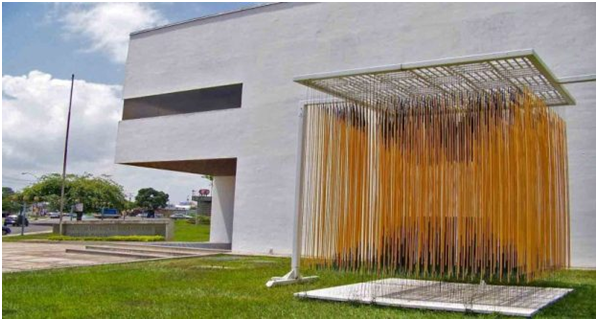
El edificio del Museo de Arte Moderno Jesús Soto es producto de la mente productiva del arquitecto venezolano Carlos Raúl Villanueva diseñó una estructura de corte funcionalista, en sintonía con los principios artísticos de las obras que forman parte de la colección del museo. Villanueva, en ésta, una de sus últimas obras, aplica su filosofía de integrar el diseño arquitectónico con la pintura, la escultura, el paisaje y el hombre, la llamada “síntesis de las artes”. Para su construcción se tardó un poco más de tres años. El museo consta de siete salas para exposición, fundamentalmente, de pinturas, de las cuales tres sirven de lugar para la muestra de las obras de Soto, además hay dos bellos jardines que son enriquecidos con magnificas esculturas. En la edificación se consigue una relación armónica entre los espacios cubiertos y los jardines, que se consolida con la incorporación de los penetrables Azul y Blanco de Soto, allí, el visitante puede tener la experiencia única de sentir la dinámica, el movimiento y el carácter sensorial de la obras de Jesús Soto.
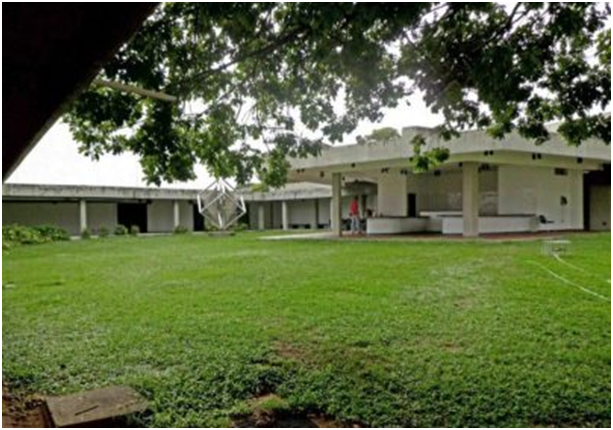
El museo fue construido en dos etapas, la primera de ellas, inaugurada en 1973, consta de cinco edificaciones cuadrangulares de diversos tamaños unidos por un sistema de puentes que unen y separan a su vez las salas de exposición, armando un sistema de corredores; los cuales se organizan en torno a un patio-jardín de esculturas obras que, combinadas con el paisajismo y la propuesta arquitectónica, enriquecen aún más la experiencia que se vive en toda la visita al museo, Villanueva logar perpetuar una atmósfera de síntesis de las artes que son una delicia estética que uno no se cansa de admirar. Esta etapa cubre un área de 1721 metros cuadrados, donde se encuentran las oficinas administrativas y las primeras salas de exposición. Para su construcción se tardó un poco más de tres años.
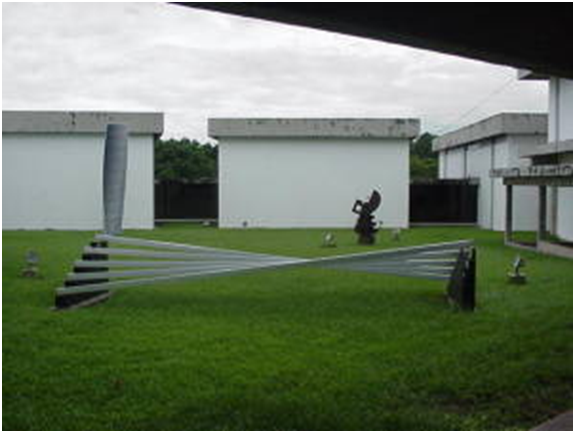
La segunda etapa fue inaugurada en 1987 conserva los lineamientos arquitectónicos dejados por el autor, respetados celosamente por los arquitectos José Carlos Villanueva y Edgar Parra. La segunda fase, de un área de 3489 metros cuadrados, consta de una sala polivalente, la biblioteca, un taller de restauración, los almacenes y nuevas salas de exposición que suman un total de 7 salas, a ello habría que agregarle 7000 metros cuadrados de áreas verdes y de estacionamiento.
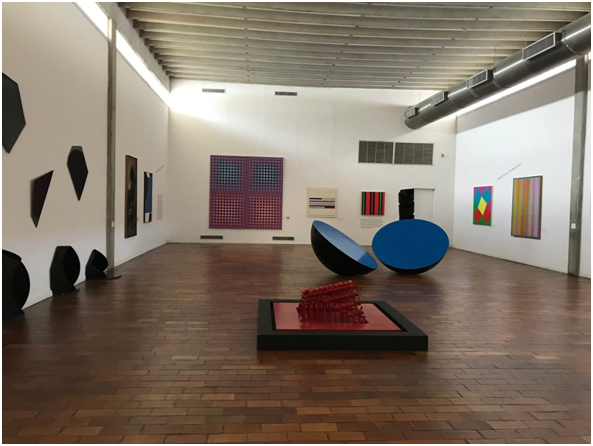
El material usado en la fabricación de ambas etapas es el concreto por considerarlo sólido y austero lo cual se manifiesta claramente en las edificaciones carentes de ornamentos, donde la obra limpia se deja ver en las juntas entre vigas, otorgándole una expresividad particular minimalista siempre desde un modelo cinético pleno de luz, sombras que son el sello de la visión cubista del espacio.
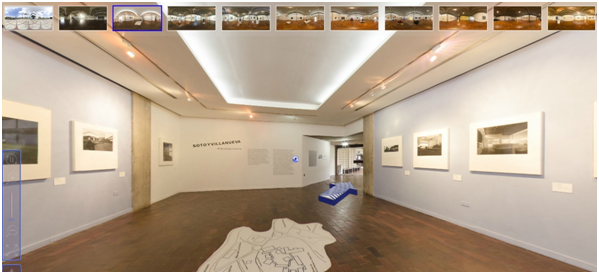
La colección del Museo de Arte Moderno Jesús Soto se compone alrededor de 730 obras propias del artista y de unos 130 artistas nacionales e internacionales del siglo XX, que muestran, además de la vanguardia rusa, el neoplasticismo y la abstracción geométrica, las tendencias típicas del siglo XX como el neoplasticismo, el cinetismo, el estructuralismo y las artes óptica, geométrica, concreta y monocromática. El espectador puede disfrutar de estos movimientos artísticos en una serie de pinturas, esculturas, múltiples, serigrafías, fotografías desplegadas a lo largo de las salas de exposición que en si mismas son piezas de arte arquitectónico. Entre los artistas con obras en el recinto museístico se encuentran Kasimir Malevich, Robert Jacobsen, Alberto Magbelli, Kenneth Snelson, Georges Rickey, Natalia Gontcharova, Pavel Mansouroff, André Heurtaux, Man Ray, Josef Albers, Jean Tinguely, Fortunato Depero, Jean Gorin, Lucio Fontana, Lajos Kassak, Víctor Vasarely, Michel Seuphor, Henryk Stazewski, Mauro Reggiani, Auguste Herbin, Sonia Delaunay, Marcel Louis Baugnet, Serge Poliakoff, Wassil Kandinsky, Johannes Itten, Jean Arp, Theo Van Doesburg, Hans Richter, Ilya Chashnik, Liubov Popova y Henryk Berlewi y, por supuesto, Jesús Soto.
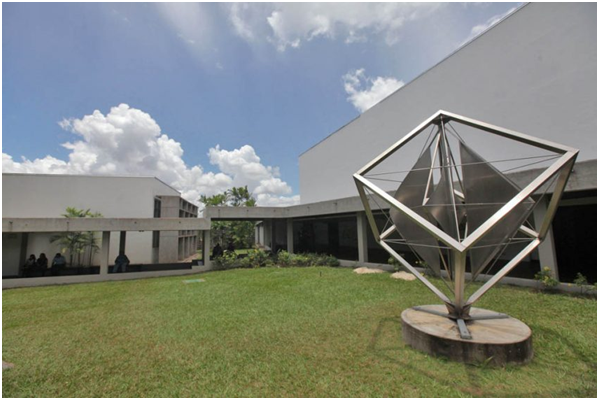
En 2011 la gobernación del Estado intervino el museo y ordenó tomar posesión de todos los bienes e inmuebles del museo. El hijo de Soto, Cristobal, quien se encontraba en Paris, protestó por el allanamiento y posterior expropiación del museo, pues en palabras del propio Cristobal Soto, lo que aconteció fue “un secuestro del inmueble y de las obras de arte de su padre y de todos los artistas venezolanos y extranjeros que generosamente decidieron ceder obras para realzar el museo y enriquecer el acervo espiritual del estado Bolívar y de la República”. Para resumir y no cansar a los lectores de Hive con las diatribas políticas del país, solo diré que en la actualidad el museo se encuentra en total deterioro, tal y como lo ha confirmado Alejandro Lanz, director del centro de investigaciones ecológicas de Venezuela.
Congratulations, your post has been added to Pinmapple! 🎉🥳🍍
Did you know you have your own profile map?
And every post has their own map too!
Want to have your post on the map too?
Congratulations, your post has been added to Pinmapple! 🎉🥳🍍
Did you know you have your own profile map?
And every post has their own map too!
Want to have your post on the map too?
is this plant vines or artificial rope material? !discovery 30
Hello juecoree, as far as I know, it was built with artificial rope material. . Thank you for reading this post. I hope you enjoyed it
This post was shared and voted inside the discord by the curators team of discovery-it
Join our community! hive-193212
Discovery-it is also a Witness, vote for us here
Delegate to us for passive income. Check our 80% fee-back Program
Thanks to the discovery-it team for reading my post about the Soto Museum. Best regards
Hello Benjamín. Jesús Soto must have been extremely ecstatic knowing that the Modern Art Museum has been named after him! The great thing here is that he was still able to enjoy prestige, recognition, and honor during his active life before his demise in 2005. Thought-provoking terms like Metamorphosis, Kinetic Structures, and Neoplasticism are just some of the innovative artistic principles that have made him a renowned success. Hopefully, this museum will be revived to its former glory in due time. A remarkable Venezuelan artist indeed @besamu!
I totally agree with you. Soto, together with Cruz Diez, are two of the most conspicuous representatives of kineticism of the last century. Those of us who love art and architecture are eager for the great works built before the present regime to be repaired and preserved for future generations, such as the Soto museum and the university city of Caracas, just to give a couple of examples. Best regards and thank you for your excellent feedbacks
Congratulations @besamu! You have completed the following achievement on the Hive blockchain and have been rewarded with new badge(s) :
Your next target is to reach 3000 upvotes.
You can view your badges on your board and compare yourself to others in the Ranking
If you no longer want to receive notifications, reply to this comment with the word
STOPCheck out the last post from @hivebuzz:
Support the HiveBuzz project. Vote for our proposal!
Hola @besamu Gracias por mostrar el museo que lleva el nombre de nuestro gran artista de renombre mundial y padre del cinetismo nacional Jesús Soto. El domingo, mientras celebraba el cumpleaños de mi esposa, aproveché y tomé una fotografía de una de sus maravillosas obras, La Esfera Naranja, que está ubicada en la Autopista Francisco Fajardo. Aquí la Esfera Naranja. Saludos y bendiciones.
Fuente / Source
Hola profesor, esa obra de Soto "La esfera Caracas", como creo se llama, es espectacular y nosotros tenemos la suerte de poder disfrutarla cada vez que pasamos por la Autopista. No podía estar en el post porque solo estaba escribiendo sobre el Museo de arte moderno Jesús Soto. Gracias y buenas noches. Mis felicitaciones y respeto para su esposa en su recién pasado cumpleaños.
Es excelente lo explayado, muy instructivo, saludos.
Well done @besamu! We're happy to inform you that this publication was especially collected and awarded RUNNER-UP in Architecture Brew #27. Congratulations!
Subscribe to Architecture+Design, an OCD incubated community.